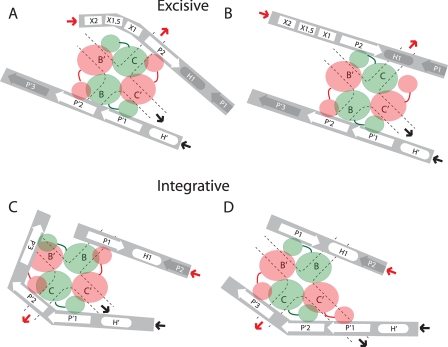FIGURE 8.
Schematics depicting alternative configurations of the N-domain and arm-type site interactions in the integrative and excisive Holliday junction recombination intermediates. The symbols and notation are the same as in Fig. 1, B–D, protein-bound sites are denoted by white symbols, unbound sites are in gray symbols, and solid heavy arrows denote where arm DNA is joined to the branches of the HJ. In the excisive HJ intermediate, three arm-type sites (P2, P′1, and P′2) are bound by the indicated N-domains, with a fourth N-domain either interacting with Xis (A) or free in solution (B). In the integrative HJ complex, four arm-type sites(P1, P′1, P′2, and P′3) are bound by N-domains of the Int tetramer. Accommodation of the third P′ arm-type site is achieved either by primarily altering the trajectory of the P′ arm DNA (C), by altering the orientation and position of the N-domain/linker region (D), or by some combination of both (see “discussion” and Fig. 1B).

